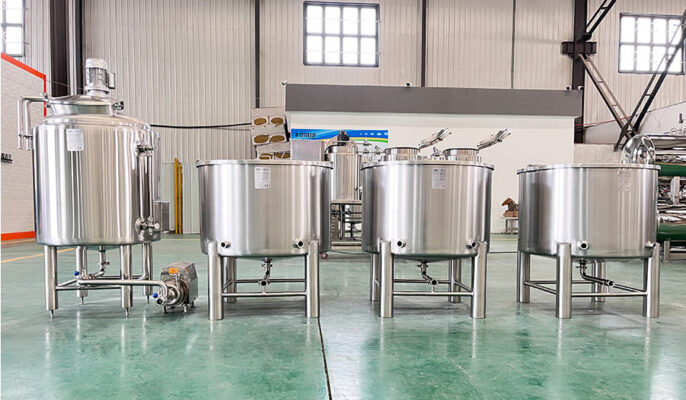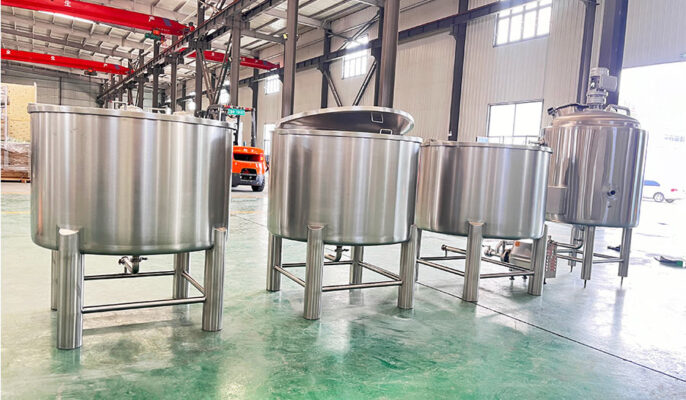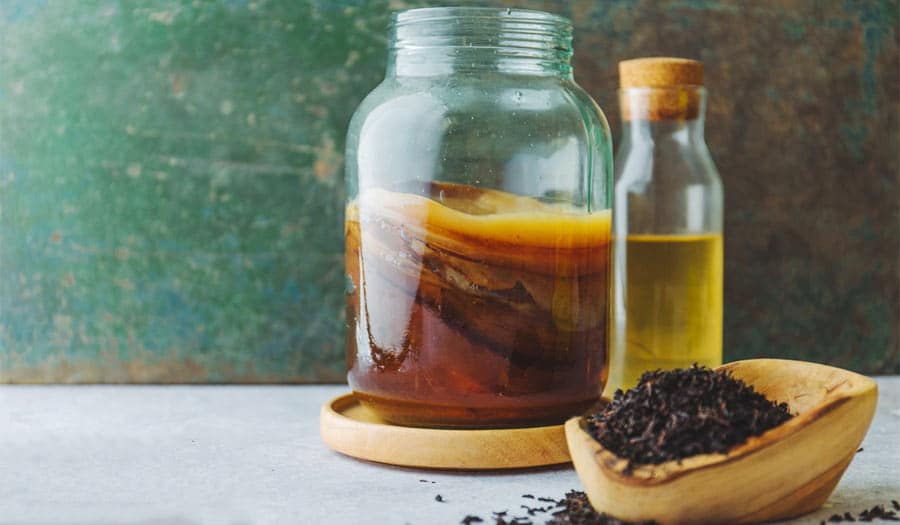Kombucha, a beverage rich in probiotics and a unique taste, is gradually becoming a star product that attracts much attention in the market. Behind this, the kombucha brewery, as the production base of this healthy drink, plays a vital role. To ensure the quality and taste of kombucha, a series of professional and efficient equipment is required in the brewing process. This article will elaborate on the main equipment required for a kombucha brewery and its important role in the production process.
Qu'est-ce qu'une brasserie Kombucha ?
A Kombucha Brewery is a place that specializes in producing Kombucha. Kombucha is a fermented tea beverage that is usually made from sweetened tea and a yeast called a SCOBY (Symbiotic Colony and Yeast). Breweries typically use different types of tea leaves and sugars, which go through a fermentation process to produce a unique flavor and bubbles. Kombucha is popular for its potential health benefits, including improving digestion and boosting immunity. Breweries may offer a variety of flavors to suit different consumer preferences.

Characteristics of Kombucha Brewery
- Fermentation process: Brewery focuses on fermentation using SCOBY, a process that usually takes several days to several weeks to produce unique flavors and bubbles.
- Diverse flavors: Many breweries offer a variety of flavors of kombucha, using different teas, sugars, and natural flavors such as fruits, herbs, and spices to meet the different needs of consumers.
- Natural ingredients: Most kombucha breweries tend to use organic and natural ingredients and avoid artificial additives and preservatives to maintain the healthy attributes of the drink.
- Small batch production: Some breweries may adopt a small batch production method to ensure the quality and freshness of each batch.
- Health awareness: Kombucha is popular for its potential health benefits, and breweries usually emphasize its probiotics, antioxidants, and other nutrients.
- Sustainability: Many breweries pay attention to environmental protection and use sustainable production methods and packaging materials to reduce the impact on the environment.
- Education and experience: Some breweries also provide tours and tasting activities to introduce consumers to the production process and health benefits of kombucha and enhance consumer participation.
De quel équipement une brasserie de kombucha a-t-elle besoin ?
- Bouilloire : La bouilloire est un équipement essentiel pour la préparation du thé sucré, le premier ingrédient du kombucha. Elle permet au brasseur de contrôler la température, la durée et les ingrédients du thé sucré afin de produire un kombucha homogène et de haute qualité.
- Cuve de fermentation: Une cuve de fermentation est un grand récipient, généralement en acier inoxydable, utilisé pour fermenter le kombucha. La cuve de fermentation doit être équipée de systèmes de contrôle de la température, d'agitation et de circulation d'air afin de maintenir des conditions optimales pour la culture du kombucha et d'éviter toute contamination.
- Matériel de filtration et d'embouteillage : Les équipements de filtration et de mise en bouteille sont utilisés pour éliminer les particules et les sédiments du kombucha et les transférer dans des bouteilles ou d'autres récipients. Les équipements de filtration et d'embouteillage doivent être capables de gérer le débit et la pression du kombucha et d'éviter les déversements, les fuites et les déchets.
- Équipement d'étiquetage et d'emballage : L'équipement d'étiquetage et d'emballage est utilisé pour apposer des étiquettes et des scellés sur des bouteilles ou d'autres récipients et les emballer dans des cartons ou d'autres matériaux. L'équipement d'étiquetage et d'emballage doit être capable d'appliquer les étiquettes et les emballages de manière précise et efficace et de garantir qu'ils sont correctement fixés et scellés.
- Matériel de réfrigération : Le matériel de réfrigération est utilisé pour refroidir et conserver le kombucha avant et après son conditionnement. L'équipement de réfrigération doit être capable de maintenir la température et l'humidité requises et d'empêcher le kombucha de s'abîmer et de se détériorer.
- Matériel de nettoyage et de stérilisation : Le matériel de nettoyage et de stérilisation est utilisé pour nettoyer et stériliser les cuves de fermentation, le matériel de filtrage et d'embouteillage, ainsi que d'autres surfaces et ustensiles afin de prévenir la contamination et la détérioration. Le matériel de nettoyage et de stérilisation doit pouvoir éliminer la saleté et les débris et tuer les bactéries et autres micro-organismes sans endommager le matériel ou le kombucha.
- Réservoir lumineux: Kombucha open-fire tanks are usually made of stainless steel and equipped with lids, pressure gauges, temperature sensors, carbonation stones, and multiple valves. They are sealed pressurized tanks used to control the temperature and carbonation of kombucha and allow flavors and aromas to develop and blend. Kombucha open-fire tanks are important equipment for producing kombucha because they allow brewers to control the quality and consistency of kombucha.
- Water treatment equipment: Water treatment equipment is used to purify, filter, and sterilize water used to brew kombucha. Water treatment equipment should be able to remove impurities, bacteria, and other contaminants and ensure the safety and high quality of water.
- Heating and Cooling Equipment: Heating and cooling equipment is used to generate the heat, steam, and cooling required for the kombucha brewing plant. The equipment should be able to efficiently and sustainably generate the required heating and cooling needs and reduce dependence on the grid and impact on the environment.

What materials to choose for équipement de brassage de kombucha?
Verre
Glass is the best choice for brewing kombucha. Not only does it not react to the acidity of beer, but it is also less likely to scratch or contain chemicals like BPA. You need a capacity of at least 1.5 liters, but 2 liters or larger is better. For continuous brewing systems, a larger glass jug with a spigot is needed. Make sure the spigot inside the jug is plastic and not metal, as metal can damage the kombucha. But you need to make sure the glass is secure and does not shatter.
Plastique
Plastic is cheap and easy to make, but be careful when using plastic. Due to the acidity of kombucha, only certain types of plastic are suitable for brewing kombucha. Plastic is generally cheaper than glass, but you need to make sure it won’t scratch or break, and sometimes plastic is not as strong as glass.
Acier inoxydable
Stainless steel is a material used in the fermentation process of beer, wine, kombucha, and spirits. Stainless steel is the material of choice for many commercial breweries and professional home breweries because it is durable, scratch-resistant, stain-resistant, and has excellent temperature control properties. However, stainless steel fermenters tend to be more expensive than other materials.
Materials to Avoid
Avoid crystal/colored glass, inferior stainless steel, brass, aluminum, cast iron, consumer-grade plastics, rubber, and any materials not listed in the “Approved” section above. These are not suitable for kombucha production.
How to choose the right kombucha brewing equipment?
Choix de la taille
When choosing a kombucha brewing vessel, the first thing to consider is whether its capacity can meet your brewing needs. Choose the right size of the vessel based on your production plan, that is, the amount of kombucha you want to brew at a time. Make sure the container has enough space for the SCOBY (the yeast and bacteria symbiont in kombucha) and the fermenting liquid to fully expand and react.
Matériau
Choose a brewing vessel made of glass or ceramic. These materials are ideal because they are non-reactive and will not interact with the acidity of kombucha. Avoid containers made of plastic or metal because they can leach chemicals into the brew, affecting the taste and quality of kombucha.
Assurance qualité
It is important to invest in high-quality equipment that is designed specifically for kombucha brewing. This equipment must meet food safety standards and have excellent durability to withstand the various conditions during the fermentation process. High-quality equipment will not only last longer, but also provide you with a better brewing experience.
Facilité d'utilisation
When choosing equipment, also consider its ease of cleaning, assembly, and use. Regular maintenance and cleaning are essential in the kombucha brewing process, so choosing equipment that is easy to clean and sterilize will save you a lot of trouble. At the same time, looking for lids that are easy to remove and replace, as well as equipment that is easy to operate, will make the brewing process smoother and more enjoyable.

FAQ
Qu'est-ce que le Kombucha ?
It is a fermented tea drink made from biofilm. It tastes a bit like apple cider vinegar and is simple and easy to make at home. Kombucha contains many vitamins, especially B vitamins.
What are the common automation systems?
PLC, industrial PC, and touch screen HMI help to automate and control the process.
What production capacity does a commercial Kombucha plant need?
Batch sizes of around 100 liters are feasible. Large producers ferment over 5000 liters.
What is the optimal temperature for Kombucha fermentation?
The optimal fermentation temperature is around 23°C. It is recommended to control within +/- 1°C.




